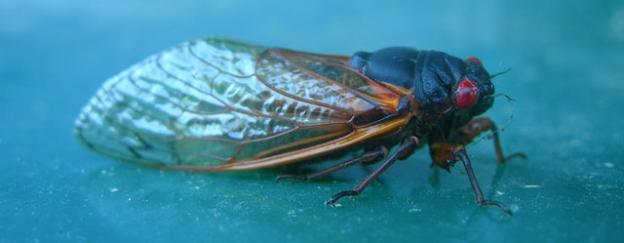Listening to Diane Rehm this morning I was reminded of a slightly bizarre event that happened one warm night back in December, a couple of nights before Christmas. We had come home from a party late and were sitting out on the deck. The crickets were totally going off, and suddenly I noticed that if I held my ears just right, it sounded like they were playing the first 12 bars of "The Carole of the Bells." I mean, it was uncanny. And they went on and on. BUM-ba-pa-pa BUM-ba-pa-pa BUM-ba-pa-pa BUM-pa-pa-pa. When a jet flew overhead, with its red-and-green wingtip lights flashing a syncopated rhythm, the scene turned into a slightly psychedelic Corona beer TV ad.
David Rothenberg, philosopher-musician and author of Bug Music: How Insects Gave Us Rhythm and Noise, would not have been surprised. As he explained to Ms. Rehm, the "organized noise" that crickets, birds and other critters make is genuine music, some of it as sophisticated as that made by humans.
In fact, he posits, these sounds may be what caused our species to evolve to create music.
Here's a bit from his new book.
All around us the sounds of the world emerge as music. It’s not just that all sound is sound, take it or leave it, but real music is sung by the creatures of this planet, who have evolved to communicate with structures and patterns of mystery.
That last phrase is just about the most poetic thing I've read in weeks. Later:
The stridulation of crickets, the tymbaling of cicadas, the tap-tap-tapping of treehoppers, the thrum of bees … most people like these sounds. The rhythms of insects bind us to the landscape, the warm weft of early autumn, a smile at the seasons’ march. One small sense that ties us to the eternal, for like all animal sounds, they have been around for millions of years longer than anything human. And the most important thing about them is that they may be the very source of our interest in rhythm, the beat, the regular thrum.
Rothenberg previously wrote about the music of birds in Why Birds Sing, and then accompanied and wrote about humpback and beluga whales in Thousand Mile Song.
Here's a short clip of him and his band jamming with a bunch of bugs—totally worth a listen:
Rothenberg's visit to the DR Show was timed to coincide with the emergence of the 17-year cicadas in the Northeast. These three incredible species (genus Magicicada) (!), which live completely synchronized life cycles, will all emerge from the ground at the same time in various locations, in swarms of millions upon millions. It will happen sometime in the next few days, when the soil temperature eight inches below the surface hits 64 degrees.
Over a few hours, the bugs will then go through a rapid metamorphosis, transforming from flightless (disgusting-looking) "nymphs" into large, big-eyed flying insects.
Within another few hours the males will gather in trees and set up "chorus centers" to attract females for mating—clearly an early example of the evolutionary behavior that later resulted in teenaged boys forming rock bands.
The resulting thrum of thousands of tymbaling cicadas is hypnotic. I have only vague memories of the Brood II emergence in New Jersey in 1962, when I was seven years old, but I caught the tail end of the Brood X emergence in 2004 in DC and could not believe my ears.
The mechanism by which the Magicicada produce this music is also almost unbelievable. They do it not by rubbing their body pars together, like fiddling crickets, but by using internal muscles known as "tymbals." Wikipedia has a terrific explanation:
Contracting the internal tymbal muscles produces a clicking sound as the tymbals buckle inwards. As these muscles relax, the tymbals return to their original position producing another click. The interior of the male abdomen is substantially hollow to amplify the resonance of the sound. A cicada rapidly vibrates these membranes, and enlarged chambers derived from the tracheae make its body serve as a resonance chamber, greatly amplifying the sound. The cicada modulates the sound by positioning its abdomen toward or away from the substrate. Additionally, each species has its own distinctive "song".
(Note the scare-quotes around "song." Clearly the author will change his/her tune after reading Rothenberg.)
The East Coast is going mad for cicadas this spring. My favorite Brood II-related event is being put together by the cool nerds at NPR's Radiolab. Project Cicadas features an emergence map, as well as a DIY device for predicting the mergence of the bugs in specific locales.
The Cicadas Are Coming! from Radiolab on Vimeo.
And here's a version of "Carol of the Bells," true name "Shchedryk," which is Ukranian for "Bountiful Evening." As it happens the tune is derived from a prehistoric folk chant, thought to have magical properties. The original text was not about bells at all, but told "the tale of a swallow flying into a household to proclaim the plentiful and bountiful year that the family will have." Bird song?
Homepage photo by Philip N. Cohen via Wikimedia Commons.













